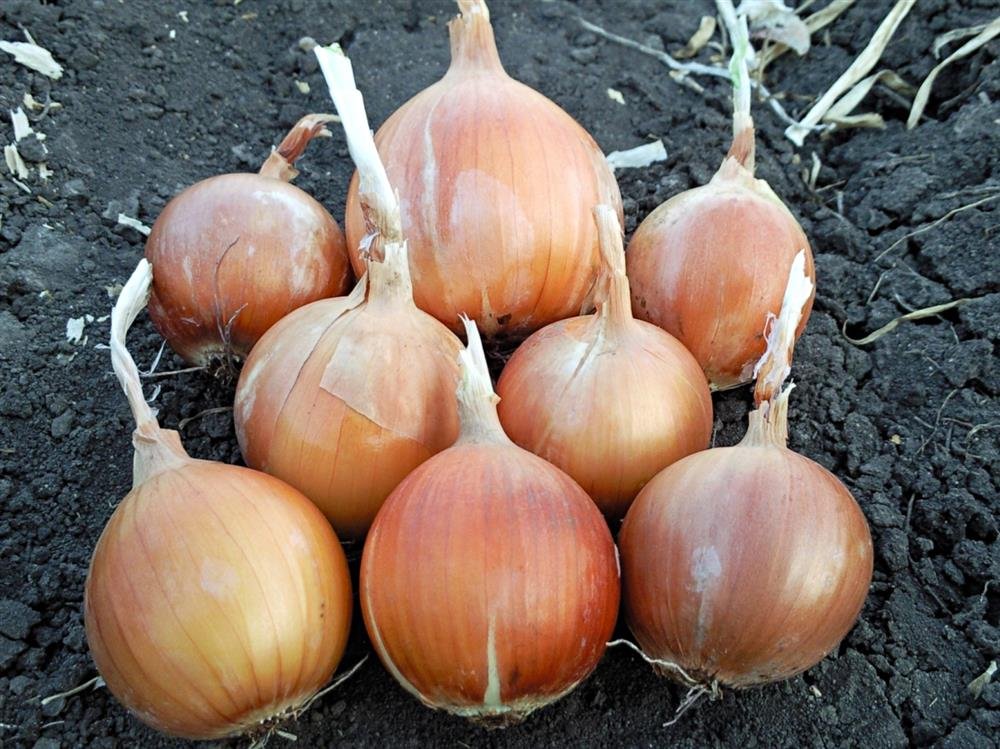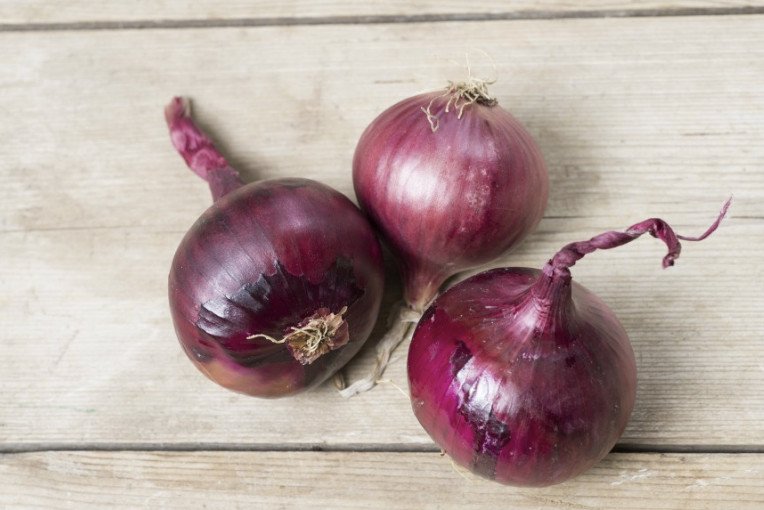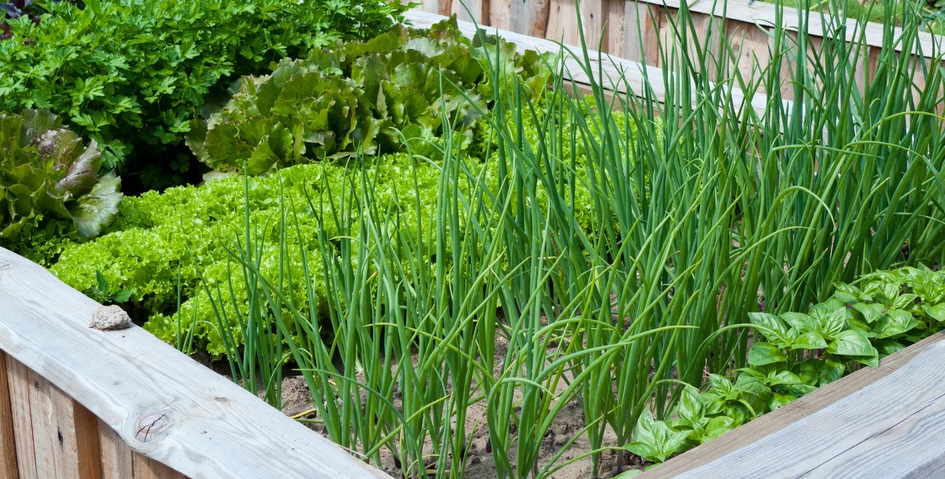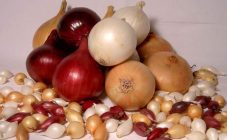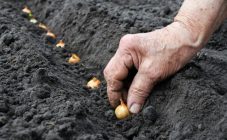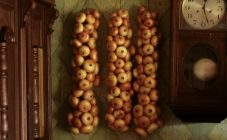The history of onion development is long - more than 6 thousand years old. Initially, the culture was not treated as a vegetable product - it was perceived as a medicinal plant. There are many interesting facts about the bow that have come down to us from the olden days. So, the ancient Romans were sure that the plant is able to strengthen the courage of soldiers. Therefore, onions have become an indispensable component in the diet of warriors.
The ancient Egyptians fed the pyramid builders with bows, hoping to give them strength. Even on the Cheops pyramid there is a record that about 40 tons of silver were spent on the purchase of garlic and onions.
In the Middle Ages, the onion plant was considered the only salvation from pestilence. He was also credited with a mythical property - the fruit, allegedly, protected from witchcraft and evil eyes.
History is silent about when exactly the bulb could appear in Russia. But the fact that the vegetable has been used in folk medicine since ancient times is confirmed by ancient herbalists.
Description of culture
It is difficult to find a person who does not know what onions look like, because they are distributed everywhere. True, some are interested in which family the onion belongs to. Garlic and all onions belong to the Liliaceae family, despite the fact that it is not a flower, but a herbaceous product from the garden.
The description of the onion will be brief - the plant consists of a head, which in the shape and color of the husk resembles the turnip familiar to ancient Russians. In fact, the fruit is a modified shoot, where the bottom is a shortened stem, its scales are something like a bark.
Green feathers are leaves, hollow inside. Gives plants and seeds, popularly called "nigella" (so rich in their dark color). Seeds are formed in an umbrella crowning a long, hollow arrow shot by a bow. Outwardly, it resembles a green feather, but at the time of seed formation it becomes dense and fleshy.
The culture is cold-resistant, capable of germinating at 2 degrees Celsius. For plant development, the optimum temperature is 18-20 degrees.
Cultivation of onions is carried out in one-year and two-year revolutions, taking in reproduction the seed-nigella, sets, samples or seedlings.
Since onions are a vegetable, turnips and feathers are used for food. The product is consumed by most people daily in raw, boiled, fried, pickled form. Cooking, perhaps, desserts is not complete without onions.
Onion varieties
Onions have many classifications. First of all, the culture is divided into:
- a turnip suitable for storage - it is denser, stronger and has a strong smell;
- sweet, used exclusively fresh.
In addition, attention should be paid to subspecies that more thoroughly define the category of the region.
Onion subspecies
| Name | Features: |
|---|---|
| Southern | Heat-loving varieties, not only growing poorly in cold regions, but also capable of losing their dignity; · The subspecies is characterized by a large head size (usually elongated or round) and a sweet, sometimes semi-sharp taste; Such bulbs are not stored for long, therefore they are used as salad |
| Northern | · More often the subspecies is called insular, which reflects the main feature of the varieties; Such bulbs are not stored for long, therefore they are used as salad · In this category, the bulbs grow small and flattened. These also include multi-nested varieties; · The turnip has good keeping quality, therefore it is suitable for winter storage; Based on the name, more zoned under the Urals and Siberia |
All varieties of onions are also divided by ripening time and place of cultivation. For example, Troitsky, Spassky, Bessonovsky are cultivated not only in the open field - the varieties are also used in greenhouses for forcing winter greens.
Popular varieties of onions
| Name | Features: |
|---|---|
| Aleko | · Grown from both seeds and seedlings; · The bulb has a dense, rounded, weighing up to 60 g. The yield is stable, from nigella you can get up to 2 kg / sq. m; · Has 2 layers of scales, tightly adjacent to each other. Juicy are painted white with purple veins, dry ones - in delicate ultramarine; Has a pungent taste and is suitable for long-term storage |
| Bessonovsky | · The main place of zoning is the Non-Chernozem belt; · Belongs to mid-season varieties and is grown from seed; · Dicotyledonous, but often in one nest up to 5 rounded-flattened yellow bulbs with an average weight of 40 grams each are formed. From one square meter, you can take up to 2.5 kg of turnip; Fruit has a spicy taste, good keeping quality |
| Golden Semko | · Grown in almost all regions. In the south - in a one-year crop rotation, in the Moscow region and northern regions - in a two-year (from seedlings and seedlings); · Refers to early maturing varieties - the entire growing season takes no more than 3 months. At the same time, maturation at the time of harvesting is maximum; · The bulb grows round in shape, with a pronounced pungent taste, the average weight is 80 g. White juicy scales on top are covered with dry light brown with a yellowish tint; The yield is stable and is about 3.5 kg per square. The variety is very responsive to watering, therefore, by adjusting irrigation, you can achieve larger fruits; The keeping quality of the bulbs is determined at 90%, which allows the turnip to maintain its presentation for 7 months |
| Buran | · A late-ripening variety with a stable yield - up to 1.2 kg is obtained from a square; · Monocotyledonous, at the same time gives 3 rudiments of a feather, therefore it is interesting for those who plant rounded bulbs for forcing greenery; · The fruit is dense, large, covered with intensely yellow scales on top, reaches an average weight of 95 g. It is universal in use, has a sharp taste; · Suitable for two-year cultivation and has maximum ripeness; · High keeping quality is characteristic, but the variety is prone to powdery downy mildew. More resistant to other fungal and bacterial diseases |
| Red baron | · It develops well from seed and is capable of producing up to 1.5 kg per square meter when grown annually. In planting with sevkom, the yield increases (especially if you apply the Chinese bed method); · The turnip ripens in 90-95 days from the moment of sowing the seeds and gives a flattened juicy red pulp, covered with darker scales; · The taste is semi-sharp. The variety is prized for its high content of ascorbic acid |
In addition to onions, gardeners are actively growing other onions of the Liliaceae family. Some species are distinguished by their taste, others by biological characteristics, but all are popular in use.
Varieties of bows
| View | Species characteristics | Agrotechnics |
|---|---|---|
| Leek | · It is often used in food instead of onions - leeks have a more delicate sweet taste. Apparently, because of this, the species was named "pearl"; · Does not have a pronounced bulb. A thick, tall false stem is eaten (it looks like a slight swelling at the base of a plant), which should be thoroughly cleaned and washed from sand before use; Dense elastic feathers keep in the refrigerator for a long time | · Leeks are planted in seedlings, since it reaches ripeness in six months; · The cultivation technology, like a turnip, is one thing - and a two-year cultural turnover. Therefore, their growing conditions are the same; Popular varieties: Bandit, Goliath, Premier, Tango, etc. |
| Batun (origin - Central Asia) | · Relatively new garden plant for European latitudes (compared to onions); · Long-term representative of the family, giving the maximum production for the 3rd year; · Looks like a turnip, but with a less pronounced head. In this case, a clearly distinguishable leg (like a leek) is not formed | · The earliest type of bow. Propagated from seeds by sowing in the middle of summer and by divisions in autumn; · The scheme for planting a trampoline can be used from the agrotechnics of onion, embedding planting material to a depth of 1-2 cm; · To get quality products, it is necessary to remove arrows in time; Recommended varieties resistant to diseases: April, Baron, Tenderness, Russian winter, Ural family |
| Shallot | · Artificially grown multifloat culture; · One adult bush gives about 30 independent heads, but they are much smaller than traditional turnips; The taste of the teeth is intensely piquant, and the aroma is delicate sweetish | · Propagated by nigella and slices; · Planting and care completely coincide with the cultivation of a turnip; It is worth paying attention to the varieties: Family, Bonnil hybrid, Zvezdochka, Emerald, Strong, Firebird |
| Schnitt | · Another perennial that can be found everywhere in the wild (even in the Far North); · The species has a long growing period in one place, but the most productive chives are the first 3-4 years; · The onion gives small, but tasty. Dark green thin feathers have a cilantro scent | · Can reproduce by seedlings and cuttings planted in the beds in the fall; · Many people believe that chives are an indoor version of onions, therefore they are actively bred on windowsills and loggias; Recommended varieties: Albion, Crocus, Bohemia |
| Canadian | · Another variety of onions, the appearance of which in summer cottages was noted quite recently. The view attracted the attention of gardeners with its multi-tiered nature; · The plant gives air bulbs (bulbs) no more than 3 cm in diameter. They are located in 4-5 tiers along the entire length of the arrows. | · The main points of agricultural technology are standard. The difference lies in the way of reproduction; Since the plant does not give seeds, use the vegetative method - dividing the bush or air bulbs, carrying out work in spring or autumn; Popular varieties Odessa winter 12 and Gribovsky 38 |
It does not matter which species the summer resident prefers for cultivation - all onions have a high nutritional potential and healing value. Therefore, it is worth diversifying not only garden beds, but also your diet.
Culture properties
Onions are especially useful fresh, since some of the phytoncides evaporate during heat treatment. This component is the strongest antimicrobial agent that can even fight tuberculosis, cholera and typhus.
Bows are prized for their great medicinal chemical composition, which includes:
- vitamin set, where the main elements are B (1,2,6), C, E, PP;
- mineral salts (iron, phosphorus, potassium, etc.);
- enzymes, inulin, carotene;
- sugars in some varieties can contain up to 14% (a significant proportion is accounted for by maltose and fructose);
- pantothenic acid.
Eating fresh onions every day helps:
- lower blood sugar;
- establish water-salt metabolism;
- increase the tone of the muscles of the gastrointestinal tract and improve the secretion of the glands;
- raise your appetite;
- normalize libido.
Onion extract is used in pharmacology. Its presence can be found in the composition of the preparations "Alliglycer", "Allilchep" and a number of dietary supplements. Vegetable juice helps to remove baldness and seborrhea, and onion masks are beneficial in preventing wrinkles.
Properties of other types of onions
| Name | Features: |
|---|---|
| Leek | It contains less phytoncides than a turnip, but much more mineral salts. Therefore, the bactericidal effect is weaker, but the effect on the function of the digestive glands and liver is higher. It helps well with metabolic disorders and overwork |
| Batun | Contains 2 times more ascorbic acid than onion. In pharmacology, drugs are made from batun for the elasticity of blood capillaries and for lowering pressure. In Tibet, batun is included in recipes for fractures and furunculosis. The Chinese use the Tatar onion as a diaphoretic and energy product |
| Shallot | Judging by what vitamins are in onions and shallots, what is the effect of species on the human body, we can say that this variety is a complete analogue of a turnip |
| Schnitt | In terms of composition, onions are the record holder in the content of ascorbic acid and mineral salts among all types. Therefore, it begins to act effectively on the disease immediately. |
| Multi-tiered | It can be considered an analogue of a turnip, but it can contain 2 times more vitamin C |
Each type of onion deserves to become an alternative to the traditional onion head not only in culinary recipes, but also in folk therapy, like a free "doctor" from the garden. They all have a similar healing effect.
Contraindications
There are people who cannot stand the taste and smell of fresh onions; they may develop allergic reactions to the product. A vegetable should be completely excluded from the diet for a number of cardiovascular diseases. Onions harm in acute and severe forms of diseases of the kidneys, liver and gastrointestinal tract.
About pests
Those who have a summer residence often plant onions near beds with other crops (the root crop wins especially) to scare away insects, and plants are treated with onion infusion. But the vegetable itself also gets from pests - flies, hidden proboscis (it is also called a weevil), thrips. It is easy to avoid their aggression if you strictly adhere to the rules of cultivation.
